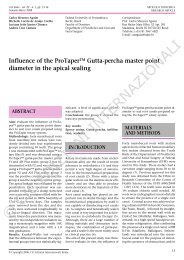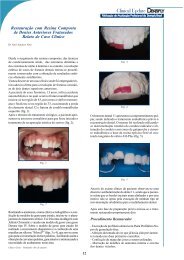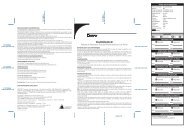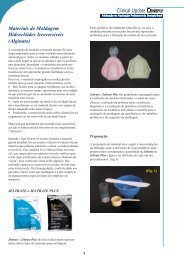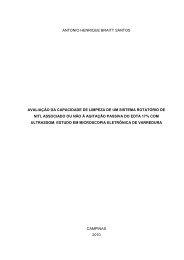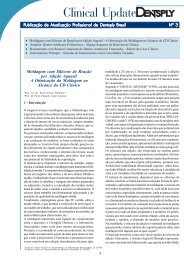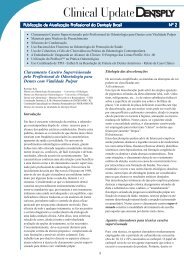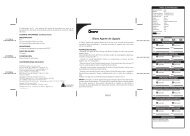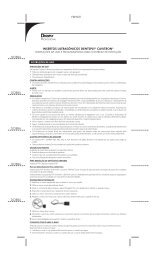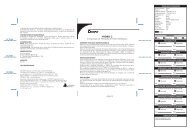Create successful ePaper yourself
Turn your PDF publications into a flip-book with our unique Google optimized e-Paper software.
van Dijken et al<br />
DISCUSSION<br />
The rapid progression of adhesive materials during the last<br />
20 years has resulted in a situation where many adhesive<br />
systems have been replaced by modified successors which<br />
were claimed to be better without clinical validation. Clinical<br />
trials have been limited in number since they require several<br />
years of regular recalls. Enamel-resin bonds produced after<br />
acid etching with phosphoric acid have proven satisfactory<br />
and stable over time. 2,5,6 Adhesion to dentin, on the other<br />
hand, has been difficult to achieve because of the substrate’s<br />
wet nature. The efficacy of dentin bonding can be<br />
demonstrated in cervical abrasion/erosion lesions without<br />
involvement of the contiguous enamel. These surfaces are<br />
ideal to test clinical dentin bonding because they are widely<br />
available. 12 Therefore, no enamel bevel was made in the<br />
study and care was taken not to involve the enamel surface<br />
contiguous with the lesions during the etching-priming step.<br />
However, many of the lesions still contained a small enamel<br />
margin in the incisal area, and the evaluation of clinical<br />
retention to only dentin tissue was therefore not 100%. At<br />
the end of the two years, the recall rate was high (130/133).<br />
The retention rate for the adhesive system was 92.3%.<br />
Türkün recently reported a 96% retention rate after one year<br />
for the same adhesive. 16 For provisional acceptance, the latest<br />
guidelines of the American Dental Association (Dental<br />
and enamel adhesive materials: ADA, Council on Dental Materials,<br />
Instruments, and Equipment, 1994) for submission<br />
of dentin and enamel adhesive materials require that no<br />
more than 5% of the restorations have been lost and not<br />
more than 5% of the restorations may show microleakage at<br />
the 6-month recall. To obtain full acceptance, the cumulative<br />
incidence of clinical failures in each of two independent clinical<br />
studies has to be lower than 10% lost restorations and<br />
10% microleakage after 18 months. The dentin retention<br />
rates for the tested adhesive were 3.1% and 6.9% at 6 and<br />
18 months, respectively, fulfilling the ADA guidelines for<br />
enamel-dentin adhesive systems. There were no significant<br />
differences in clinical retention rates between the restorations<br />
placed with the resin composite or the polyacid-modified<br />
resin composite. The hypothesis was therefore not accepted.<br />
Kemp-Scholte et al 8 showed that materials with lower<br />
elasticity modulus can act as an elastic buffer, which relieved<br />
contraction stresses and improved marginal integrity.<br />
Since most polyacid-modified resin composites include<br />
resins with a modulus of elasticity value between those of<br />
resin composite and glass-ionomer cement, these materials<br />
may work as a stress-breaking barrier between the tooth and<br />
the composite. 1 A significantly better adaptation was observed<br />
with the SEM replica technique for a polyacid-modified<br />
resin composite/resin composite sandwich technique<br />
compared to resin composite only restorations. 9 However,<br />
the same authors could not show any clinical evidence for<br />
the interfacial adaptation results observed by SEM. No significant<br />
statistical or clinical differences were observed between<br />
the two techniques during 3- and 9-year periods. 10,11<br />
The polyacid-modified resin composite tested in the present<br />
study has a modulus of elasticity value close to that of resin<br />
composite materials, which may partly explain why no differences<br />
were observed (personal communication, E. Asmussen).<br />
CONCLUSION<br />
It can be concluded that the single-step self-etching adhesive<br />
showed acceptable clinical retention rates during the<br />
evaluation period, independent of restorative material used.<br />
ACKNOWLEDGMENTS<br />
This study was supported in part by the County Council of Västerbotten<br />
and <strong>Dentsply</strong> DeTrey, Konstanz, Germany.<br />
REFERENCES<br />
1. Attin T, Vataschki M, Hellwig E. Properties of resin-modified glass-ionomer<br />
restorative materials and two polyacid-modified resin composite materials.<br />
Quintessence Int 1996;27:203-209.<br />
2. de Munck J, van Landuyt K, Peumans M, Poitevin A, Lambrechts P, Braem M,<br />
van Meerbeek B. A critical review of the durability of adhesion to tooth tissue:<br />
methods and results. J Dent Res 2005;84:118-132.<br />
3. Dijken van JWV. A clincial evaluation of anterior conventional, microfiller and<br />
hybrid composite resin fillings. A six year follow up study. Acta Odont Scand<br />
1986;44:357-367.<br />
4. Dijken van JWV. Multi-step versus simplified enamel-dentin bonding systems-<br />
Réalités Cliniques 1999;10:199-222.<br />
5. Dijken van JWV. Durability of new restorative materials in Class III cavities. J<br />
Adhes Dent 2001;3:65-70.<br />
6. Frankenberger R, Krämer N, Petschelt A. Long term effect of dentin primers<br />
on enamel bond strength and marginal adaptation. Oper Dent 2000;25:11-<br />
19.<br />
7. Gernhardt CR, Biesecke G, Schaller HG. Tensile bond strength of a self-conditioning<br />
dentin adhesive system in vitro [abstract 338]. J Dent Res<br />
2003;82:B 55.<br />
8. Kemp-Scholte CM, Davidson CL. Marginal integrity related to bond strength<br />
and strain capacity of composite resin restorative systems. J Prosth Dent<br />
1990;64:658-664.<br />
9. Lindberg A, Dijken van JWV, Hörstedt P. Interfacial adaptation of a Class II<br />
polyacid-modified resin composite/ resin composite laminate restoration in<br />
vivo. Acta Odont Scand 2000;58:77-84.<br />
10. Lindberg A, van Dijken JWV, Lindberg M. A 3-year evaluation of a new open<br />
sandwich technique in class II cavities. Am J Dent 2003;15:33-36.<br />
11. Lindberg A, van Dijken JWV, Lindberg M. 9-year evaluation of a poly-acid-modified<br />
resin composite open sandwich technique in class II cavities. J Dent<br />
2007;35:124-129.<br />
12. Peumans M, Kanumilli P, De Munck J, van Landuyt K, Lambrechts P, van<br />
Meerbeek B. Clinical effectiveness of contemporary adhesives: A systematic<br />
review of current clinical trials. Dent Mater 2005;21:864-881.<br />
13. Siegel S. Nonparametric Statistics. New York: McGraw-Hill, 1956.<br />
14. Tay FR, Pashley DH. Water-treeing – a potential mechanism for degradation<br />
of dentin adhesives. Am J Dent 2003;16:6-12.<br />
15. Tay FR, Pashley DH, Yiu CKY, Sanares AME, Wei SHY. Factors contributing to<br />
the incompatibility between simplified-step adhesives and self-cured or dualcured<br />
composites. Part I. Single-step self-etch adhesive. J Adhes Dent<br />
2003;5:27-40.<br />
16. Türkün LS. The clinical performance of one- and two-step self-etching adhesive<br />
systems at one year. J Am Dent Assoc 2005;136:656-664.<br />
Clinical relevance: The adhesive showed a good clinical<br />
performance during the 2 year follow-up in noncarious cervical<br />
lesions.<br />
Vol 9, Supplement 2, 2007 243



